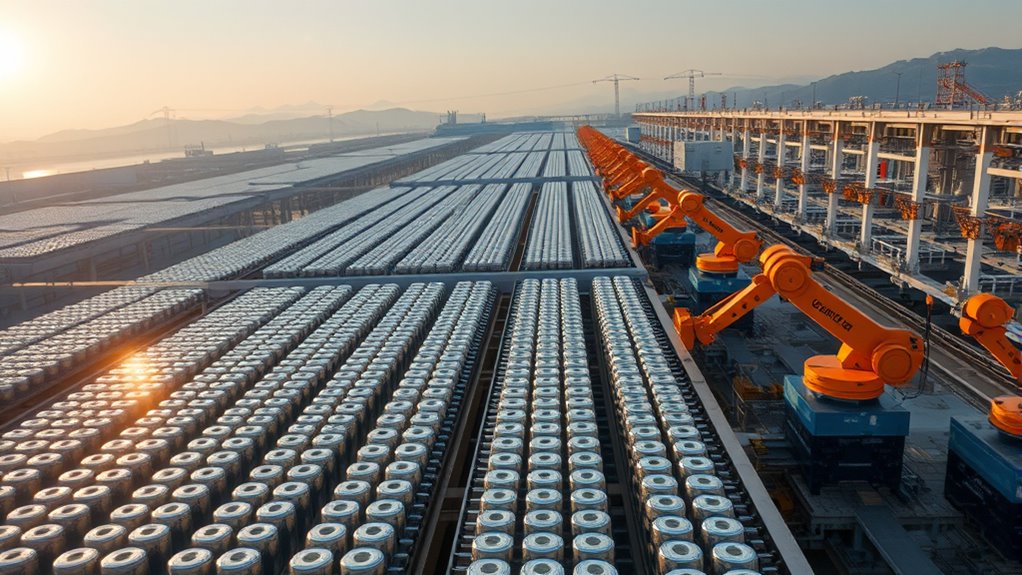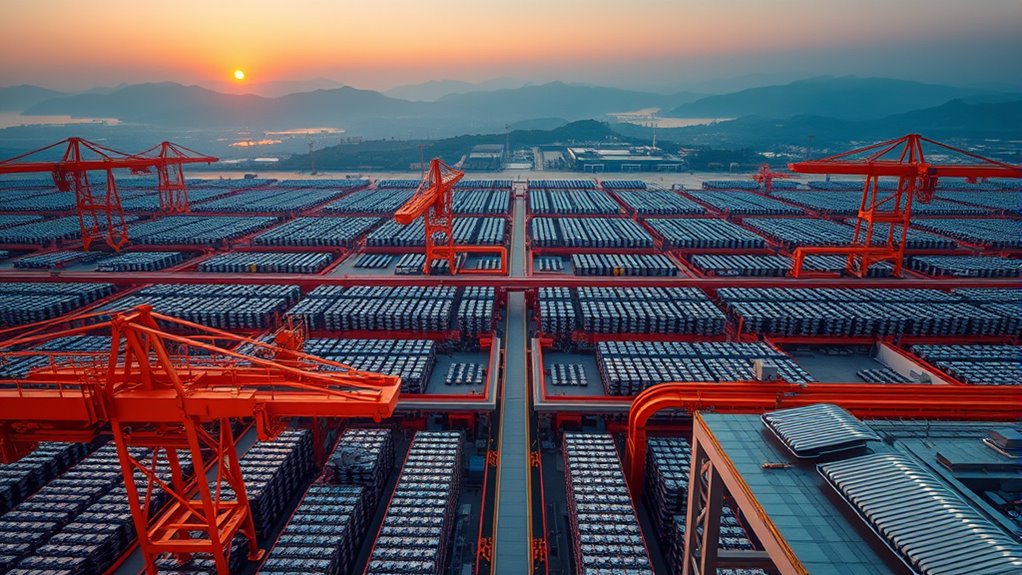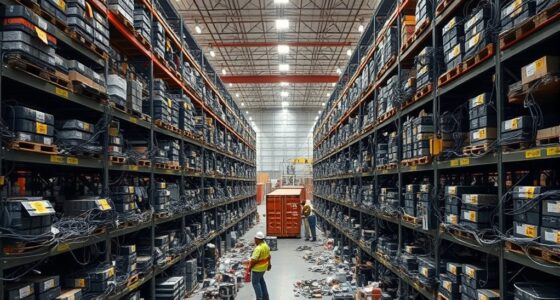China became the world’s battery superpower by strategically controlling critical raw materials like lithium, cobalt, and nickel through government-backed investments and domestic mining. They built a fully integrated supply chain from extraction to manufacturing, making it hard for others to catch up. Their support for innovation and infrastructure guarantees they stay ahead. If you continue exploring, you’ll see how these tactics shape the future of energy and industry worldwide.
Key Takeaways
- China’s strategic control of raw materials and vertical integration ensures cost-effective, reliable battery supply chains.
- Government policies and investments prioritize domestic mining, processing, and innovation in battery technologies.
- China’s dominance in critical resources like lithium, cobalt, and nickel secures a competitive edge globally.
- Heavy investments in infrastructure and R&D enable rapid scaling and technological advancement.
- Barriers to entry, including extensive supply chain control and geopolitical advantages, make catching up difficult for competitors.

Have you ever wondered how China became a global leader in battery production? It’s a story built on strategic control of the entire battery supply chain and raw material dominance. China didn’t just focus on manufacturing; it invested heavily in securing every step of the process. This means controlling not only the factories that assemble batteries but also the raw materials like lithium, cobalt, and nickel that go into them. By dominating these pivotal resources, China guarantees a steady, low-cost supply, giving it a massive advantage over competitors. This raw material dominance means other countries face higher costs and supply uncertainties, making China’s leadership even more entrenched.
China’s battery dominance stems from controlling raw materials and entire supply chains, securing low-cost, reliable resources.
The Chinese government played a key role by prioritizing battery technology and raw material extraction as national strategic interests. They provided subsidies, financing, and policies that encouraged domestic mining and processing of critical minerals. This allowed China to build a robust supply chain that’s difficult for outsiders to replicate. When you look at how Chinese companies develop vertically integrated operations, it’s clear they’re not just manufacturing batteries—they’re controlling everything from mineral extraction to final assembly. This vertical integration reduces dependency on external suppliers and shields China from market shocks or geopolitical disruptions.
Additionally, China’s aggressive investments in infrastructure and research have fueled innovation, making their battery production more efficient and cost-effective. They’ve also established a vast network of processing plants that convert raw materials into usable cathodes and anodes. This tight control over the raw material supply chain means they can scale production rapidly, which is pivotal in the fast-growing electric vehicle market. For other countries trying to catch up, this presents a significant challenge. They not only have to develop their own battery manufacturing capabilities but also need to build a comparable raw material supply chain, something that takes years and billions of dollars.
Furthermore, China’s strategic partnerships and access to global markets reinforce its lead. They have established trade agreements and invested in mineral-rich regions worldwide, further securing their raw material supply. This thorough approach creates a formidable barrier for newcomers attempting to enter the market. If you’re wondering whether anyone can catch up, it’s clear that replicating China’s integrated supply chain and raw material dominance would require an enormous amount of time, resources, and political will. Without a similar level of strategic planning and investment, it’s unlikely that other countries will match China’s position as the world’s battery superpower anytime soon. Additionally, the development of advanced processing technology is crucial for maintaining competitiveness in this evolving industry.
Frequently Asked Questions
How Does China’s Battery Industry Impact Global Renewable Energy Efforts?
Your actions in the global renewable energy efforts are greatly influenced by China’s battery industry. Its dominance in the supply chain guarantees a steady flow of affordable batteries, accelerating renewable adoption worldwide. However, this market influence can also pose risks, like dependency on China. You benefit from the industry’s growth but should be mindful of diversifying supply sources to maintain resilience and support sustainable energy development globally.
What Environmental Concerns Are Associated With China’s Battery Production?
You should be aware that China’s battery production raises environmental concerns like environmental impact and resource depletion. The extraction of raw materials such as lithium and cobalt can harm ecosystems and deplete finite resources. Additionally, manufacturing processes often produce pollution and waste, which can damage local environments. These issues highlight the need for sustainable practices to balance battery industry growth with environmental preservation.
How Do Chinese Policies Support Battery Technology Innovation?
Imagine a fertile ground where innovation blossoms. China’s policies act like a nurturing sun, fueling growth through generous government subsidies and open research collaborations. These initiatives encourage companies and scientists to push the boundaries of battery technology. By fostering a collaborative environment, China accelerates breakthroughs, turning its industry into a powerhouse. Your focus on supportive policies helps China stay ahead, making it a global leader in battery innovation.
What Are the Major Challenges China Faces in Maintaining Battery Dominance?
You face major challenges in maintaining battery dominance, including supply chain vulnerabilities that can disrupt raw material flow and technological barriers that hinder innovation. Competition from other countries intensifies, pushing you to diversify sources and invest heavily in R&D. Additionally, environmental concerns and geopolitical tensions threaten stability. Staying ahead requires addressing these issues proactively, strengthening your supply chains, and fostering breakthrough technologies to sustain your leadership position.
Can Other Countries Develop Competitive Battery Industries Independently?
You can develop competitive battery industries independently, but it’s challenging due to market barriers and the need for technological independence. Countries must invest heavily in R&D, secure raw materials, and build advanced manufacturing facilities. Without strong government support or collaboration, catching up to China’s scale and efficiency is tough. Still, with strategic focus and innovation, some nations can carve out niche markets and gradually establish their own battery industries.
Conclusion
So, as you see, China’s rise as a battery giant gently shifts the landscape, setting a new rhythm for global innovation. While others may dream of catching up, they must navigate a winding path filled with challenges and quiet opportunities. The future remains a delicate dance, where the balance of power could subtly tip in unexpected ways. In this evolving scene, patience and perseverance might just be your best guides.










